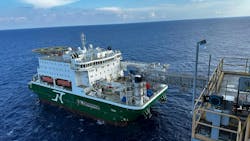Digital tools enhancing offshore safety
By Tor-Erik Rong, ScanReach
In the offshore oil and gas industry, safety is paramount. The complexity of operations, combined with remote and hazardous environments, places high demands on HSE systems. Traditional methods—manual muster drills, paper-based logs and radio communication—are increasingly seen as insufficient in meeting modern expectations for speed, accuracy and responsiveness. Digital tools are now emerging as essential components of safer, smarter offshore operations.
How traditional safety systems fall short
Manual safety systems have long been the norm offshore. Muster drills involve headcounts and radio checks; personnel movement is logged via paper or fixed-location badge scans. These systems are functional but prone to delays and human error, particularly during high-stress emergencies. Furthermore, they offer limited visibility into real-time crew locations and movement patterns, leaving gaps in response capabilities and situational awareness.
Shift to digital safety tools
The ScanReach-developed ConnectPOB system features automated mustering, real-time crew tracking and integrated traffic light systems for gangway management. A pilot project on Nortrans' TEMIS accommodation vessel showcased how technology can mitigate risks and optimize operations in the offshore sector.
Recent deployments of wireless connectivity platforms offshore demonstrate how digital systems can improve both routine safety and emergency preparedness. Based on real-time applications, three areas stand out:
1. Real-time crew visibility: Wearable tags paired with onboard wireless connectivity allow real-time tracking of personnel. Supervisors can instantly see who is in which zone, including confined or hazardous areas. In emergencies, this speeds up search and rescue efforts and allows better informed decisions.
2. Automated mustering: Digital mustering replaces manual headcounts. As crew members arrive at muster points, their presence is automatically logged. This reduces muster time significantly, improves accuracy and allows emergency teams to act faster and with greater confidence.
3. Smart movement and access control: Wireless systems can integrate with gangways or other entry points to manage crew transfers more safely. Automated traffic-light systems and digital logs ensure no one is left unaccounted for and support compliance with access protocols. Applicable for restricted area control as well.
The shift to digital safety tools brings operational and cultural changes. Implementation of these systems result in improved drill performance, greater situational awareness, positive crew reception and resilience of wireless technology. Some of the key findings included:
- Muster times dropped by more than 60% in some tests, with fewer errors;
- Real-time data enhanced planning and emergency response;
- Initial scepticism from crew members gave way to trust as systems proved reliable and non-intrusive; and
- Concerns about wireless reliability in steel-heavy environments were largely unfounded, as modern systems are robust and consistent.
The lessons from recent deployments show that digital HSE systems can reduce risk without adding complexity, support a shift from reactive to proactive safety cultures and enable better data-driven decisions and continuous improvement.
Looking ahead
The offshore industry is increasingly recognizing that digital safety tools aren’t just enhancements but represent a new baseline. As the regulatory environment tightens and expectations around ESG and operational safety grow, digitalization is becoming a strategic imperative.
Digital transformation in offshore safety is no longer hypothetical—it is happening now. By adopting real-time tracking, automated mustering and integrated control systems, offshore operations are becoming more resilient and responsive. The path forward is clear: the integration of connected safety technologies will play a central role in defining the next generation of offshore safety standards.
About the Author

Tor-Erik Rong
Tor-Erik Rong is the chief business development officer at ScanReach. He spearheads global growth strategy and strategic alliances across the maritime, offshore and energy sectors. With a bachelor's degree in automation engineering and extensive experience delivering technology in the petroleum, gas and offshore industries, Rong brings a blend of technical depth and commercial acumen. Passionate about maritime innovation, he champions wireless connectivity as a force to transform vessel operations—leading ScanReach’s mission to bring IoT connectivity into steel environments at sea.
